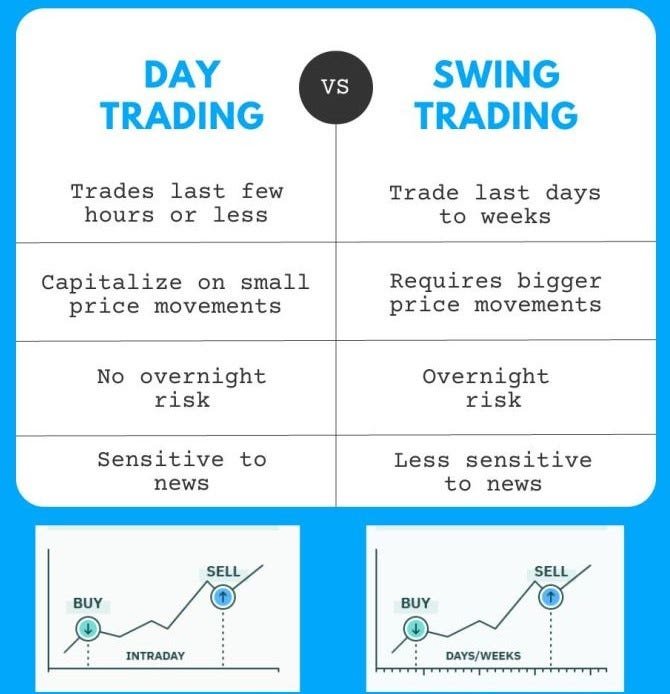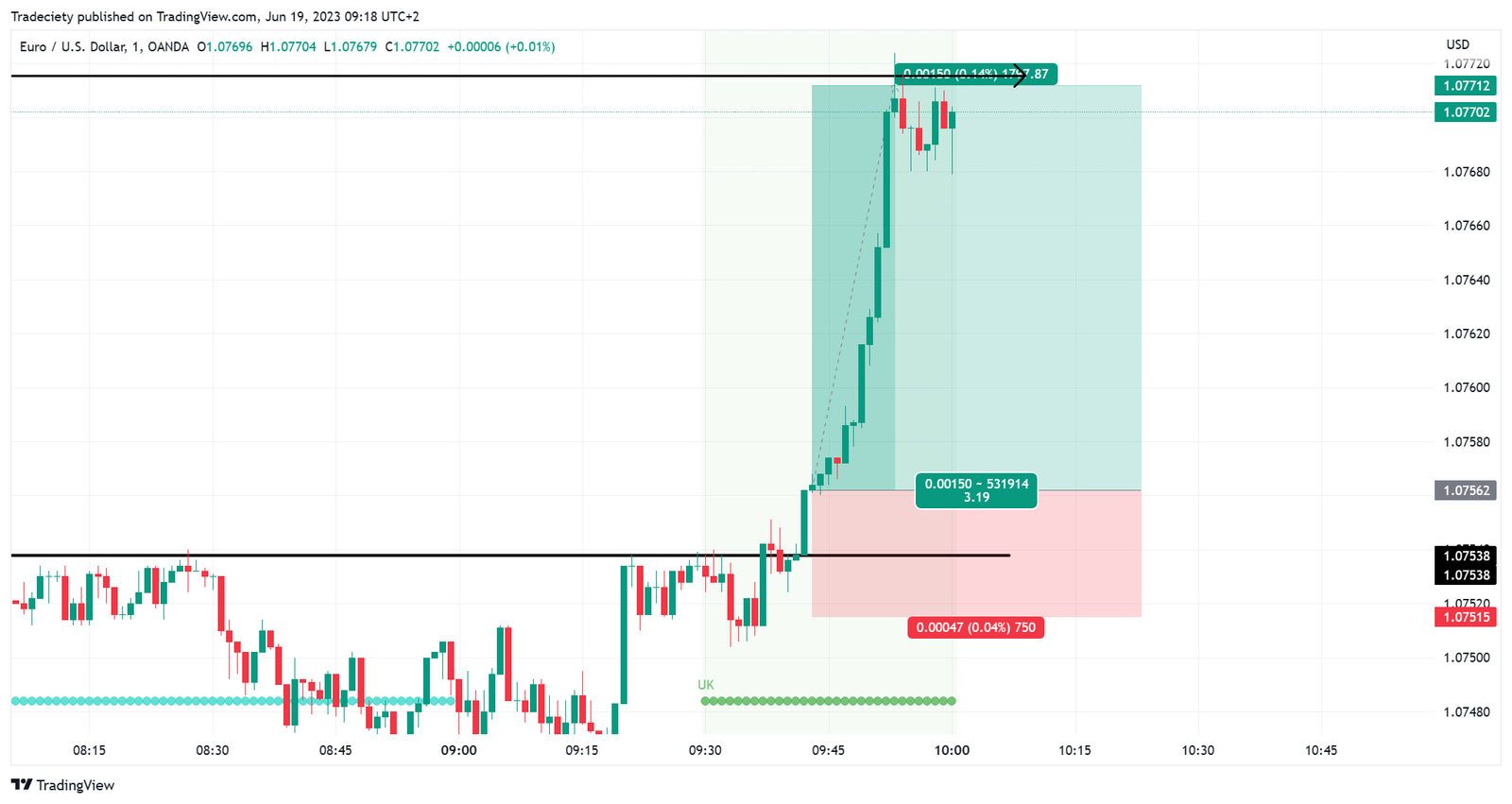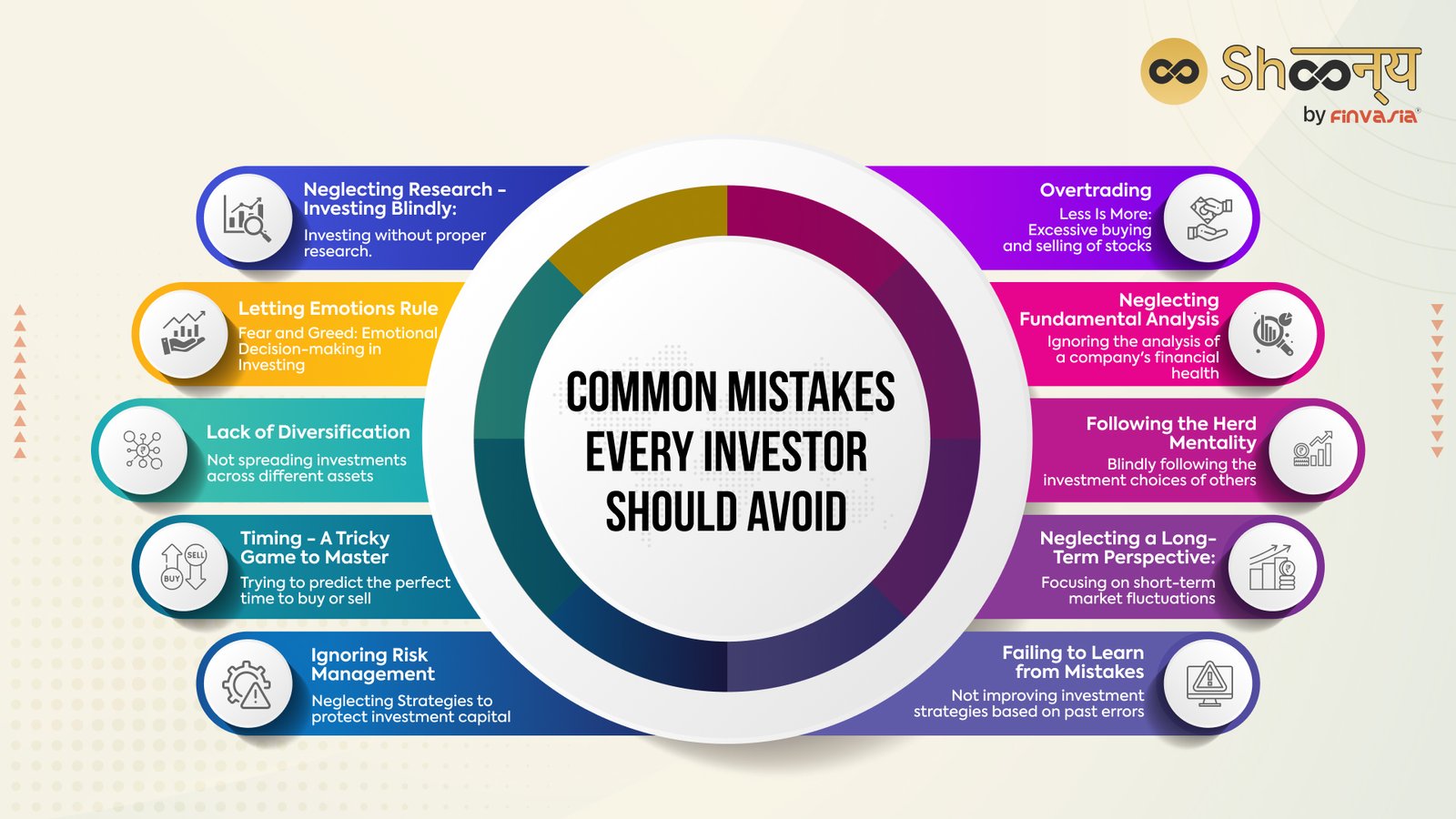In the realm of financial markets, the art of trading offers individuals myriad opportunities to capitalize on market fluctuations. However, with a plethora of trading styles available, aspiring traders face the challenge of understanding their nuances and suitability for their investment goals. Day trading, swing trading, and other approaches each present unique characteristics and return potential, catering to varying trading horizons, risk tolerance, and investment strategies. This article will delve into the distinct attributes of these trading styles, unpacking their key differences and providing insights that empower traders to make informed decisions about which approach best aligns with their trading objectives.
How do different types of trading compare?
Timeframe
Different trading styles have different timeframes, which are the periods over which traders hold their positions.
| Trading Style | Timeframe |
|---|---|
| Day trading | Minutes to hours |
| Swing trading | Days to weeks |
| Trend trading | Weeks to months |
| Long-term investing | Months to years |
Risk and Reward
The risk and reward profile of different trading styles also vary.
| Trading Style | Risk | Reward |
|---|---|---|
| Day trading | High | High |
| Swing trading | Moderate | Moderate |
| Trend trading | Low | Low |
| Long-term investing | Very low | Very low |
Trading Strategy
The trading strategies employed by different trading styles also differ.
| Trading Style | Trading Strategy |
|---|---|
| Day trading | Technical analysis, scalping, news trading |
| Swing trading | Technical analysis, fundamental analysis, chart patterns |
| Trend trading | Fundamental analysis, trendlines, moving averages |
| Long-term investing | Fundamental analysis, value investing, growth investing |
What are the four types of trading?
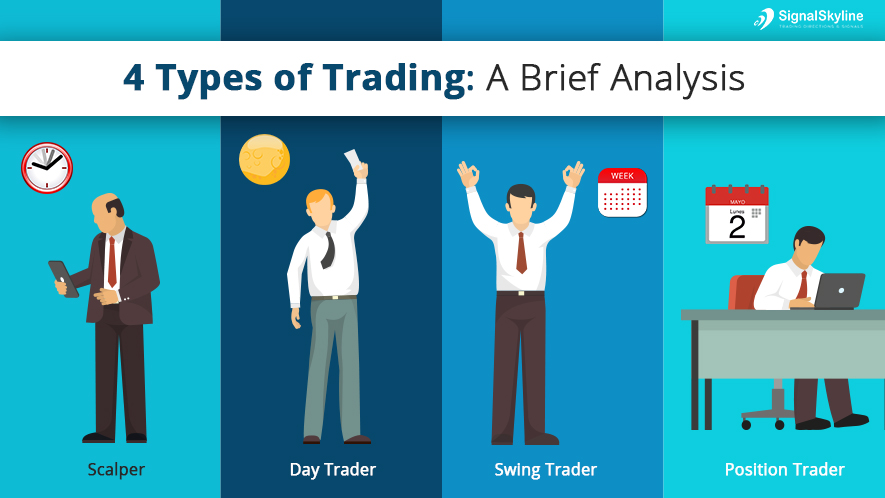
Trading can be categorized into four main types, each with its own distinct characteristics, strategies, and risks. These types are:
- Scalping: This involves taking advantage of small price fluctuations in the market. Scalpers aim to open and close trades quickly, often within seconds or minutes, to capture small profits. They rely on high trading volume and tight spreads to make their profits.
- Day Trading: Day traders also aim to capitalize on short-term price movements, but their trades typically last longer than scalping, ranging from minutes to hours. Day traders use technical analysis to identify trading opportunities and often use leverage to amplify their profits.
- Swing Trading: This type of trading focuses on capturing price swings that last for a few days to a few weeks. Swing traders use technical analysis and fundamental analysis to identify trends and entry/exit points.
- Position Trading: Position traders hold their trades for longer periods, ranging from weeks to months, and aim to profit from longer-term market trends. They often use fundamental analysis and macroeconomic factors to make their trading decisions.
What are the benefits and drawbacks of each type of trading?
Each type of trading comes with its own set of benefits and drawbacks.
- Scalping: Scalping allows traders to make numerous trades throughout the day, potentially generating higher profits in a short time. However, the high frequency of trades increases trading costs and exposes traders to significant risk.
- Day Trading: Day trading offers the opportunity to capitalize on short-term price fluctuations and potentially make substantial profits. However, the short-term nature of trades makes day trading highly demanding and requires a significant amount of time and attention.
- Swing Trading: Swing trading allows traders to capture larger price movements than day trading and involves less frequent trades. However, swing trading requires a higher level of market understanding and patience, and requires a deeper understanding of technical and fundamental analysis.
- Position Trading: Position trading is a more relaxed trading style that allows traders to focus on longer-term trends and minimize trading costs. However, position trading can be affected by market volatility and requires a significant amount of capital and patience.
How do you choose the right type of trading for you?
Choosing the right type of trading depends on your individual trading style, risk tolerance, and time commitment.
- Trading style: If you prefer fast-paced trading with numerous entries and exits, scalping or day trading might be suitable. If you prefer holding trades for longer periods and focusing on long-term trends, swing trading or position trading could be more appropriate.
- Risk tolerance: Scalping and day trading involve higher risk due to the frequent trades and potential for losses. Swing trading and position trading offer a lower risk profile but potentially lower returns.
- Time commitment: Scalping and day trading require a significant amount of time and attention. Swing trading and position trading offer more flexibility, allowing traders to focus on other activities.
Which is more profitable, day trading or swing trading?
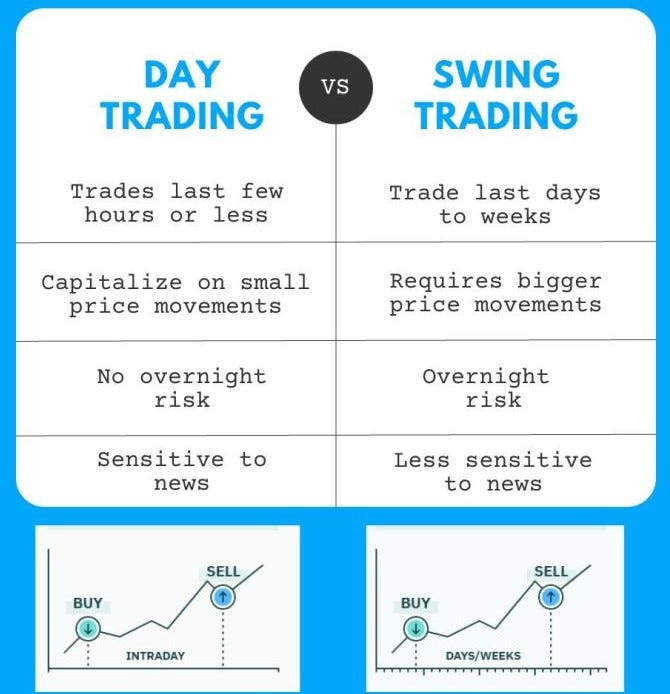
Profitability of Day Trading vs. Swing Trading
Determining which is more profitable, day trading or swing trading, is a complex question with no definitive answer. Both strategies have their own advantages and disadvantages, and ultimately, profitability depends heavily on individual skills, risk tolerance, and market conditions.
Factors Influencing Profitability
- Trading Style and Strategy: Day trading involves frequent buying and selling within a single trading day, aiming to capitalize on short-term price fluctuations. Swing trading, on the other hand, holds positions for several days to weeks, seeking to profit from larger price swings. Both styles require distinct trading strategies and risk management techniques.
- Market Conditions: Volatility plays a crucial role in both day and swing trading. High market volatility can offer more opportunities for day traders but also poses a higher risk of losses. Swing traders may benefit from sustained trends, allowing them to hold positions for longer periods.
- Trading Costs: Day traders typically incur higher transaction costs due to the frequency of their trades. Swing traders, with fewer trades, may have lower transaction costs but could face higher risk due to longer holding periods.
Individual Skills and Risk Tolerance
- Market Analysis and Technical Skills: Both day and swing trading require strong market analysis skills, but day traders need to be adept at identifying and capitalizing on short-term patterns. Swing traders may prioritize fundamental analysis and long-term trends.
- Risk Management: Both strategies require disciplined risk management to protect capital. Day traders need tight stop-loss orders and position sizing to mitigate losses. Swing traders may employ wider stop-loss levels and manage risk through diversification.
- Emotional Discipline: Both trading styles demand emotional discipline to avoid impulsive decisions based on fear or greed. Day traders face the constant pressure of market fluctuations, while swing traders may need to withstand periods of drawdown.
What type of trading is most profitable?
There is no single most profitable type of trading.
The profitability of any trading strategy depends on a variety of factors, including market conditions, your trading skills, and your risk tolerance. What might be profitable for one trader might not be profitable for another. It’s important to understand that trading involves inherent risks and there is no guarantee of profits.
However, some types of trading are generally considered to be more potentially profitable than others.
- High-frequency trading (HFT) involves using sophisticated algorithms to execute trades at extremely high speeds, taking advantage of very small price fluctuations. HFT requires significant capital and advanced technical expertise. It can be highly profitable, but it is also very risky.
- Day trading involves buying and selling assets within the same trading day. This strategy requires a high level of discipline and attention, as it involves making frequent trades and managing risk carefully. Day trading can be profitable, but it can also be very risky.
- Swing trading involves holding positions for a few days or weeks, aiming to capture price swings in the market. It requires a good understanding of technical analysis and market trends. Swing trading can be less risky than day trading, but it may also have lower potential returns.
Ultimately, the most profitable type of trading for you will depend on your individual goals, risk tolerance, and trading style.
It’s important to conduct thorough research, practice your skills, and develop a trading plan that suits your needs before diving into any type of trading.
How many trading styles are there?
Defining Trading Styles
There isn’t a single, universally agreed-upon number of trading styles. However, they are often categorized based on their fundamental approach, time horizon, and risk tolerance.
- Time-Based Styles: These styles are primarily classified by the length of time a trader holds their positions.
- Scalping: This style focuses on making small profits from very short-term price fluctuations. Scalpers often hold trades for seconds or minutes, aiming for many small wins.
- Day Trading: Day traders hold positions within a single trading day, seeking to capitalize on intraday price movements. They aim to exit positions before the market closes.
- Swing Trading: This style involves holding positions for a few days to a few weeks, capturing price swings that occur over a longer time frame.
- Position Trading: Position traders maintain trades for weeks, months, or even years, seeking to profit from long-term trends in the market.
- Style Based on Market Approach: Another way to categorize trading styles is by how they approach the market:
- Technical Analysis: Technical traders rely on charts, patterns, and indicators to identify trading opportunities. They believe past price movements offer clues about future price behavior.
- Fundamental Analysis: These traders focus on the underlying fundamentals of the assets they trade. They consider factors such as company financials, economic indicators, and industry trends to make trading decisions.
- Quantitative Analysis: Quantitative traders use mathematical models and algorithms to identify trading opportunities and manage risk. They rely on data-driven strategies and often use sophisticated computer programs.
- Other Styles:
- Arbitrage Trading: This involves exploiting price differences between two different markets for the same asset. Arbitrageurs aim to buy low in one market and sell high in another, profiting from the price disparity.
- High-Frequency Trading (HFT): HFT algorithms execute trades at extremely high speeds, taking advantage of tiny price fluctuations in milliseconds. This style requires sophisticated technology and significant financial resources.
Factors Influencing Trading Style Choice
The choice of trading style is highly personal and depends on several factors:
- Risk Tolerance: Different styles involve different levels of risk. Scalping and day trading are considered higher-risk strategies, while position trading is generally seen as lower risk.
- Time Commitment: Some styles require significant time and attention, such as scalping and day trading, while others, like position trading, can be managed with less frequent monitoring.
- Trading Capital: The amount of capital available influences the chosen style. Scalping and HFT often require substantial capital, while swing trading or position trading can be started with smaller amounts.
- Experience and Knowledge: Certain styles require specific skills and experience. Technical analysis, fundamental analysis, and quantitative analysis demand different knowledge sets.
Blending Trading Styles
Many traders don’t strictly adhere to a single style. They may blend elements from different approaches to create a unique strategy that suits their individual preferences and risk appetite. For example, a swing trader might incorporate technical analysis techniques while also considering fundamental factors.
Frequent questions
What is the difference between day trading and swing trading?
The key difference between day trading and swing trading lies in the holding period of the trades. Day traders aim to profit from small price fluctuations throughout the day, entering and exiting trades within the same trading session. They typically focus on short-term price movements and use technical analysis to identify trading opportunities. Swing traders, on the other hand, hold their positions for a longer period, typically days or weeks, aiming to capture larger price swings in the market. They often rely on fundamental analysis to identify trends and trade setups.
What are the advantages and disadvantages of day trading?
Day trading offers the potential for high returns due to its high-frequency trading style, allowing traders to capitalize on frequent price fluctuations. However, it also comes with significant risks and challenges:
- High risk: Day trading involves high leverage and frequent trades, which can amplify both gains and losses.
- Time commitment: Day trading requires significant time and dedication to monitor the markets and execute trades.
- High stress: The fast-paced nature of day trading can be stressful, as traders constantly need to adapt to changing market conditions.
- Limited returns: Day trading often focuses on small profits from short-term price movements, limiting the potential for substantial gains.
What are the advantages and disadvantages of swing trading?
Swing trading offers a more relaxed approach to trading compared to day trading, allowing traders to hold positions for longer periods and potentially capture larger price swings. This strategy often involves lower risk and stress than day trading. However, swing trading also has its disadvantages:
- Lower returns: Swing trading generally yields lower returns than day trading because traders hold their positions for a longer time, reducing the frequency of trades.
- Market volatility: Holding positions for extended periods exposes traders to higher market volatility, increasing the potential for losses.
- Time commitment: While less time-intensive than day trading, swing trading still requires consistent monitoring and analysis to manage trades effectively.
- Missed opportunities: Swing trading can miss out on smaller price movements within the overall trend, potentially limiting potential gains.
Which trading style is right for me?
The most appropriate trading style depends on individual risk tolerance, time commitment, and investment goals.
- Day trading is suitable for individuals with a high-risk tolerance, significant time availability, and a focus on short-term profits.
- Swing trading is better suited for those seeking a less stressful, lower-risk approach with longer-term investment goals.
It’s crucial to understand the pros and cons of each trading style and conduct thorough research before choosing one.

